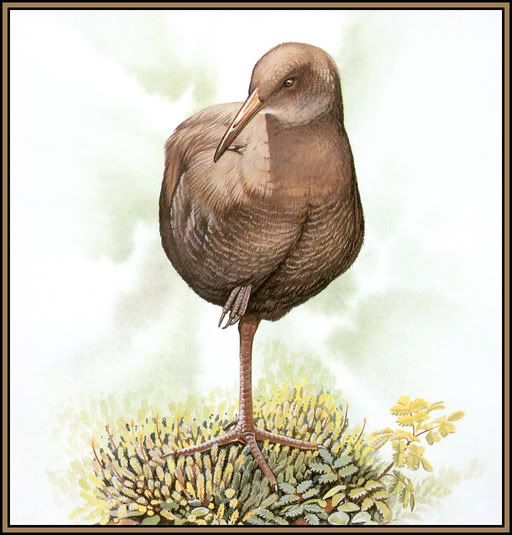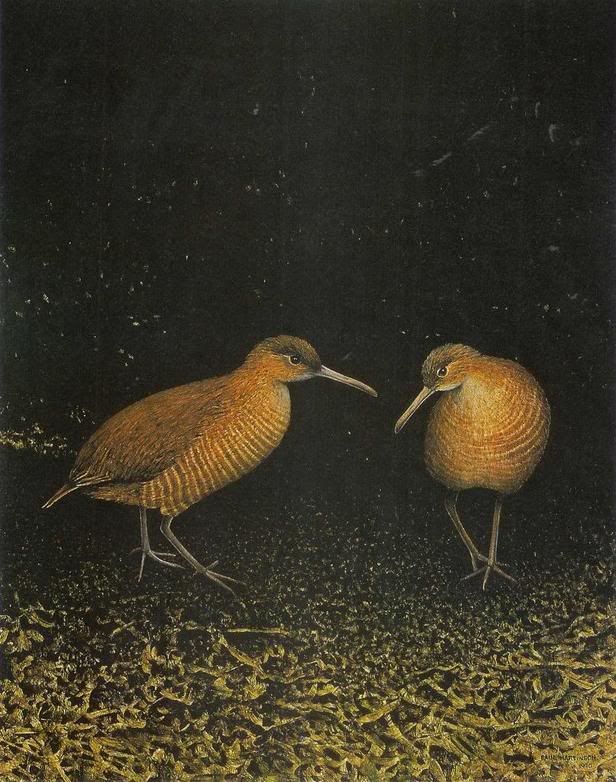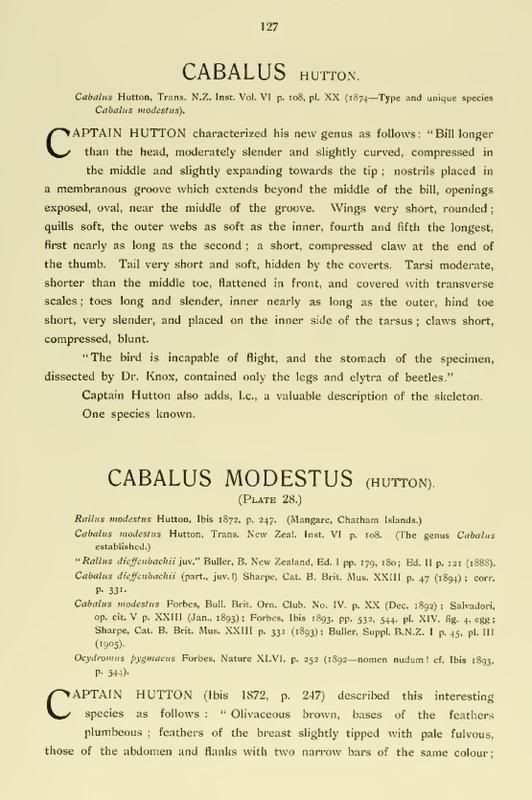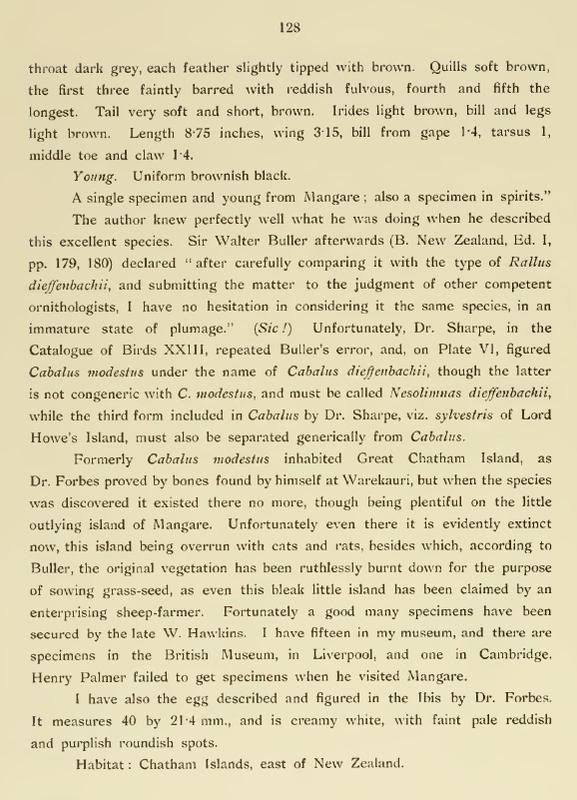|
|
Post by sebbe67 on May 16, 2005 17:05:24 GMT
Chatham Rail Cabalus modestus was endemic to Chatham, Mangere and Pitt Islands, New Zealand. It was first discovered on Mangere in 1871, and 26 specimens collected there are known from museum collections. It became extinct on the island between 1896 and 19001. Its extinction was presumably caused by predation by rats and cats (which were introduced in the 1890s), habitat destruction to provide sheep pasture (which destroyed all of the island's bush and tussock grass by 1900), and from grazing by goats and rabbits. The species is also known from 19th century bones from Chatham and Pitt Islands, where Olson has suggested that its extinction resulted from competition with the larger Dieffenbach's Rail Gallirallus dieffenbachii (also extinct), but the two species have been shown to have been sympatric on Mangere.
|
|
|
|
Post by another specialist on Jun 4, 2005 15:25:01 GMT
also known scientifically as rallus modestus
|
|
|
|
Post by another specialist on Jun 8, 2005 10:12:36 GMT
|
|
|
|
Post by another specialist on Nov 6, 2005 19:15:10 GMT
 gap in nature |
|
|
|
Post by Meakia'i on Dec 21, 2005 8:56:19 GMT
I may be horribly wrong.. but I faintly recall hearing about this species being rediscovered near a garbage dump. Or was that in the Auckland Islands?  |
|
Deleted
Deleted Member
Posts: 0
|
Post by Deleted on Dec 21, 2005 17:40:52 GMT
Hi ! Fine to have someone from Hawaii here !  The Auckland Rail ( Lewinia muelleri) has been rediscovered, the Chatham Rail not.  |
|
|
|
Post by Meakia'i on Dec 21, 2005 19:22:09 GMT
Ah... ok, thanks. And good to be here  |
|
|
|
Post by another specialist on Dec 22, 2005 19:11:24 GMT
Chatham Island Rail (Rallus modestus) last collected ca. 1900 on Mangare Island for the British Museum flightless island forest burrow dweller endemic to Chatham Islands specimens in London, Paris, and New York disappeared after deforestation and agricultural firing; also collected for museums, and declined after cat introduction References: Fuller, E. Extinct Birds of the World QL676.8.F85 1987 ISBN 0-8160-1833-2 p.73 Greenway, J. C. Extinct and Vanishing Birds of the World QL676.7.G7 1967 p.222 King, W. Endangered Birds of the World; The ICBP Bird Red Data Book QL676.7.K56 1981 ISBN 0-87474-584-5 Preamble 8 Ziswiler, V. Extinct and Vanishing Animals QL88.Z513 1967 p.107 www.uwsp.edu/geo/faculty/heywood/geog358/extinctb/ChatRail.htm |
|
|
|
Post by sebbe67 on Dec 30, 2006 15:33:46 GMT
|
|
|
|
Post by another specialist on Dec 31, 2006 11:28:12 GMT
 New Zealand Extinct Birds Brian Gill and Paul Martinson |
|
|
|
Post by another specialist on Mar 26, 2007 7:35:41 GMT
|
|
|
|
Post by another specialist on Jul 27, 2007 9:44:57 GMT
|
|
|
|
Post by another specialist on Jul 27, 2007 9:46:11 GMT
A great pdf file worth a read definately Sympatric flightless rails Gallirallus dieffenbachii and G. modestus on the Chatham Islands, New Zealand; morphometrics and alternative evolutionary scenarios Steven A. Trewick* The extinct rails Gallirallus dieffenbachii and G modestus were sympatric on at least three islands of the Chatham group Morphological and genetic evidence indicates that they evolved from the same volant ancestor, putatively the banded rail, G phihppensis Morphometnc analyses were used to compare these three species and the New Zealand flightless weka, G austrahs It is evident that both the Chatham rails were flightless, and each had undergone significant changes in body shape relative to G phihppensis G dieffenbachii was similar in overall form to the weka and most other flightless Gallirallus spp , being larger than G phihppensis in all except the wings It is possible that G dieffenbachii was a generahst feeder, as is the weka G modestus was a considerably smaller bird with a long beak that is presumably evidence of the evolution of specialised feeding behaviour General similarity between G dieffenbachii, G austrahs and most flightless members of the group results from the parallel evolution of these species in allopatry, whereby a more or less enlarged generahst feeder almost invariably results The ancestral stock of G modestus is hypothesised to be the more recent arrival on account of specialisation resulting from competition between the coloniser and the generahst resident, G dieffenbachii A general principle is proposed by which the products of later colonisations will be the more specialised through the additional selective effect of the earlier occupant |
|
|
|
Post by another specialist on Aug 7, 2007 17:42:41 GMT
Cabalus modestus Chatham Rail This species is often included in Gallirallus; recent studies indicate that it is a Gallirallus derivative (Trewick 1997). Features such as sexually dimorphic bill size are suggestive of differentiation at the generic level. Extinct. Res formerly Chatham Is. www.rosssilcock.com/ |
|
|
|
Post by another specialist on Apr 13, 2008 21:22:11 GMT
|
|
|
|
Post by another specialist on Apr 30, 2008 19:08:37 GMT
|
|
|
|
Post by Melanie on Jul 12, 2008 22:48:35 GMT
Cabalus Modestus. (Hutton's Rail.)
Rallus modestus, Hutton, Ibis, 1872, p. 247.
Rallus dieffenbachii(young), Buller, Birds of New Zealand, 1st ed. p. 180 (1873).
Cabalus modestus, Hutton, Trans. N.-Z. Inst. vol. vi. p. 108 (1874)
*I have been favoured with the following interesting note:—“I have found the MS. of a paper all
but completed, but never published, ‘Oil a comparison of the skeletons of Cabalus (= Rallus )
modestus and Rallus philippensis’; and I take the present opportunity, through Sir Walter
Buller's kindness, of adding this footnote in support of the very distinctive characters of the bird in
question— Cabalus modestus, Hutton. In the MS. above referred to I incidentally alluded to
ornithologists' recognized genera, which sometimes, when critically examined by the light of their
osteology, do not furnish convincing data of stable bony characters in support of their attributed
generic rank. In the instance of the Rail here mentioned, I then wrote:—’In anticipation of what
follows as a matter of fact, I shall adduce proofs of differentiation such as not only indicate
specific separation, but warrant generic relegation.’ I then give proofs of the bird being an adult,
or nearly so, and of its being relatively flightless. Then followed comparisons of the bones &c.,
whereof I may mention, as an epitome of results and as the drawings elucidate, that trenchant
distinctions obtain in the sternum and furcula, in the pelvis, and in the cranium and mandible, &c.
The octavo plate of illustrations thereof has been lying finished since 1874; and at the
recommendation of Sir W. Buller I intend forwarding the same with a revision of the MS. to date
to the New Zealand Institute, in whose publications first notice of the bird appeared.”—James
Murie..
Cabalus dieffenbachii(young), Sharpe, App. Voy. Ereb. and Terror, p. 29 (1875).
Ad.olivascenti-brunneus, unicolor, plumis quibusdam interscapulii et tectricibus alarum majoribus paucis
indistinctè fulvo fasciatim terminatis: supracaudalibus fulvo magis distinctè transfasciatis: facie laterali vix
cinerascente: gutture sordidè cinereo, brunnescente obscurato: corpore reliquo subtùa brunneo, dorso
concolore, sed angustè et magis distinctè fulvo transfasciato: rostro et pedibus pallidè brunneis: iride
pallidè bruanneâ.
Adult.General plumage dull olive-brown, plumbeous at the base; throat greyish, each feather tipped with
brown; feathers of the breast narrowly fringed with pale fulvous; those covering the upper part of
abdomen and sides of the body, as well as the under tail-coverts, crossed by two narrow bars of the
same colour; the first three primaries very faintly barred with reddish fulvous; tail-feathers, rump, and
thighs obscurely freckled with fulvous. Irides, bill, and legs light brown. The plumage is very soft in
texture, and the markings have the indeterminate character peculiar to young Rails.
Young.Covered with thick down of uniform brownish black.
Thissmall Ocydromine form (which I treated in my former edition as the young of Cabalus
dieffenbachii ) was obtained by Mr. Henry Travers in the small island of Mangare (one of the Chatham
Isles) in 1872; and Mr. Walter Hood informs me that it may still be obtained there, although difficult to
procure, owing to its semi-nocturnal habits.
Prof. Hutton writes:—“Both the birds obtained by Mr. H. Travers were full-grown, one accompanied
by her young one, and the other containing well-developed ova; they were both exactly alike in colour and dimensions, in neither of which do they show any approach to the colour and dimensions of R.
dieffenbachii , as may be seen by comparing descriptions of the two; while in all known Rails the young
soon acquire a plumage approaching in colour to that of the adult, and always attain their adult plumage
before breeding. In its body, tail, wings, legs, and feet. C. modestus is a smaller bird than R.
dieffenbachii , while the bills of the two are of nearly the same length; but in all Rails the legs and feet
attain the full size very early, and long before the bill acquires its full length.”
Source: Buller: A History of the Birds of New Zealand
|
|
|
|
Post by another specialist on Jul 20, 2008 19:46:56 GMT
  Extinct birds : an attempt to unite in one volume a short account of those birds which have become extinct in historical times : that is, within the last six or seven hundred years : to which are added a few which still exist, but are on the verge of extinction (1907) |
|
|
|
Post by another specialist on Jul 25, 2008 7:16:18 GMT
 Extinct birds : an attempt to unite in one volume a short account of those birds which have become extinct in historical times : that is, within the last six or seven hundred years : to which are added a few which still exist, but are on the verge of extinction (1907) |
|
|
|
Post by another specialist on Sept 7, 2008 16:34:20 GMT
|
|